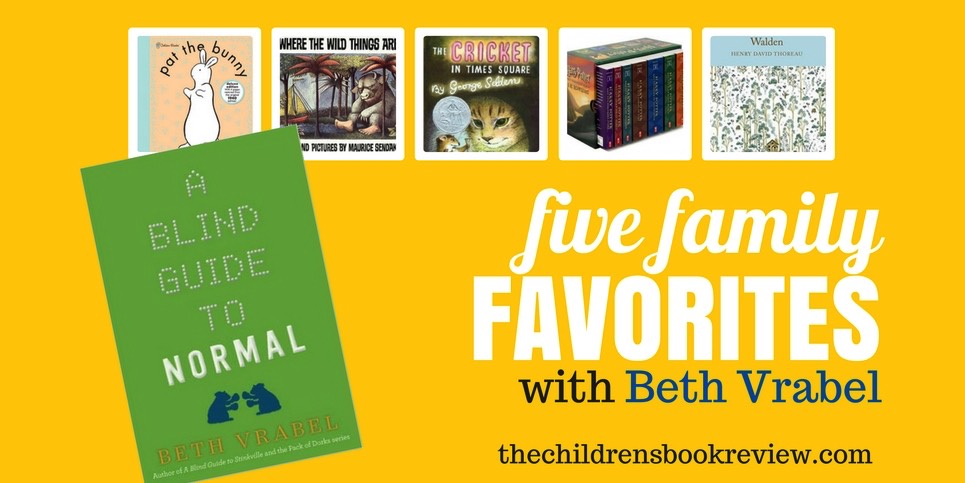
Beth Vrabel | The Children’s Book Review | October 11, 2016
The last time I had the pleasure of visiting The Children’s Book Review, I recommended five books that are so special I don’t think you should ever lend them to anyone, ever.
This time, I’m going to chat about books that have been important to my family. Some might not be so vital to our lives any more—they might even have a hefty layer of dust around their spot on the bookshelf—but they’ll always be special.
Going through these is a lot like reliving the various stages of our family life, from the heady, exhausting newborn days through chaos-isn’t-just-a-theory toddlerhood, from primary school daze right up to our present middle school mania.
These were books that helped us enjoy and navigate various stages of our family life. Be sure to let me know which ones you’d add to the list!
For the Baby Stage
Created by Dorothy Kunhardt
If our goal is for our children to turn to books with the same fervor and excitement that they do with any new toy, they need to know books are filled with adventure and fun. This simple, beautiful book is a perfect introduction. It makes me ache to have a baby on my lap, giggling as she touches the daddy’s scratchy face and solemnly putting on the mommy’s ring.
Ages 1-5 | Publisher: Golden Books| August 9, 2011 (First published in 1940.)
For the Toddler and Preschooler Era
Written and Illustrated by Maurice Sendak
Let’s face it: Toddlers are prone to losing their minds. Everything is going smoothly and then bam! Your pint-sized prince becomes a dictator-tot prone to morphing into a monster at any moment. As parents, we’re overwhelmed. Can you imagine how the child feels? Sendak’s book just does that—and ends perfectly with the child returning his safe post-tantrum world where dinner is still hot and Mommy still loves him.
Ages 4-8 | Publisher: Harper & Row | 1963 | ISBN-13: 978-0060254926
For the Primary School Years
Written by George Selden
Illustrated by Garth Williams
My son and I always read books at bedtime, but until “Cricket” those were picture books. This was our introduction to “just one more chapter!” life. The timing for reading was perfect—as the cricket finds itself searching for friends in a strange new environment, my boy was adjusting to spending his days at school and awakening to the idea that friends weren’t just people his size, but needed to be respected and valued.
Ages 7-10 | Publisher: Farrar, Straus and Giroux | 1960 | ISBN-13: 978-0312380038
For Intermediate School Years and Everyone, Anytime, Always
Written by J. K. Rowling
Not long ago, I found myself reading the last chapter of Harry Potter and the Deathly Hallows to my son. And suddenly I felt my heart constrict the way it did when the school bus doors closed behind him on that first day of kindergarten. When did I blink and this happened? Reading the Harry Potter series together meant for a half-hour each night (longer on those just-one-more-chapter nights) over a year and a half, magic was real. It meant making wands out of chopsticks, drawing Quidditch matches on scrap paper, donning Griffindor colors, and trying out Confundus on a sibling. It meant long discussions on loyalty and bravery and fate. It will always be a cherished memory.
Ages 10 and up | Publisher: Arthur A. Levine Books
For the Tween Why-Do-We-Still-Read-Together? Years
Written by Henry David Thoreau
My daughter always has been an ambitious reader. (That’s not exactly true; when she was learning to read in kindergarten, she often argued that our household would run more efficiently if she skipped learning to read, since I already knew how and could read to her, and instead concentrated on new skills such as becoming a princess.) At the end of fourth grade, when the princess dresses had long been packed away and a book rarely left her hand, my daughter’s teacher told her she had tested to the highest reading level. “The whole library is open to you now!” the teacher had said. I wasn’t so sure—yes, my daughter could understand what the individual words meant in nearly any book, but would she grasp the collective larger meaning? Reading Walden together was an amazing litmus test, particularly for a child whose favorite place to read was a high bough of a tremendous pine tree. We’d read the essays or even just segments of them, and then talk. I learned as much about myself as I did about her. We delved into such ideas as what we thought Thoreau meant when he wrote about deciding whether to be “a reader, a student merely, or a seer.” This also was my girl’s introduction to the idea that some books are destined to be underlined, circled and earmarked. Be warned, however, if you do take on Walden with your tween: My girl’s first underlined passage was: “… if I repent of any thing, it is very likely to be my good behavior.”
Ages 11 and up | Publisher: Macmillan Collector’s Library; New Edition (2016) | 1854 | ISBN-13: 978-1509826704
About Beth Vrabel
Beth Vrabel grew up in a small town in Pennsylvania. She won a short-story contest in fourth grade and promptly decided writing was what she was going to do with her life. Although her other plans—becoming a wolf biologist, a Yellowstone National Park ranger, and a professional roller skater—didn’t come to fruition, she stuck with the writing. She is the author of the Pack of Dorks series and A Blind Guide to Stinkville. Beth lives with her wonderful husband, two charming children, a spoiled rotten puppy, and Frodo the guinea pig in Canton, Connecticut.
www.bethvrabel.com | Facebook | Twitter | GoodReads | Instagram
Written by Beth Vrabel
Publisher’s Synopsis: Richie “Ryder” Raymond has a gift. He can find the punchline in any situation, even in his limited vision and prosthetic eye. During the past year at Addison School for the Blind, Ryder’s quick wit earned the respect and friendship of his classmates. Heading to mainstream, or “normal,” school for eighth grade is going to be awesome.
After all, what’s not to like? At Addison, Ryder was everyone’s favorite person. He could make anyone laugh, especially his best friend Alice. So long as he can be first to make all of the one-eyed jokes, Ryder is sure he’ll fit in just as quick at Papuaville Middle School, home of the Fighting Guinea Pigs. But Alice warns him fitting in might not be as easy as he thinks.
Turns out, Alice was right. In just the first hour of “normal” school, Ryder is attacked by General MacCathur II (aka, Gramps’s cat), causes his bio teacher to pass out cold, makes an enemy out town hero Max, and falls for Jocelyn, the fierce girl next door who happens to be Max’s girlfriend. On top of that, Ryder struggles to hold onto his dignity in the face of students’ pity and Gramps’s non-stop practical jokes.
Ryder quickly sees the only thing worse than explaining a joke is being the punchline. But with help from his stuck-in-the-70s Gramps and encouragement from Alice, Ryder finds the strength to not only fight back, but to make peace.
This exciting sequel to A Blind Guide to Stinkville weaves humor, recovery and second chances into an unforgettable story, with characters who will hook you from page one.
Ages 8-12 | Publisher: Sky Pony Press | 2016 | ISBN-13: 978-1510702288
Available Here:
Beth Vrabel, author of A Blind Guide to Normal, selected these five family favorites. Discover more articles on The Children’s Book Review tagged with Family Favorites,Beth Vrabel, and Books On Deaf And Blind.

